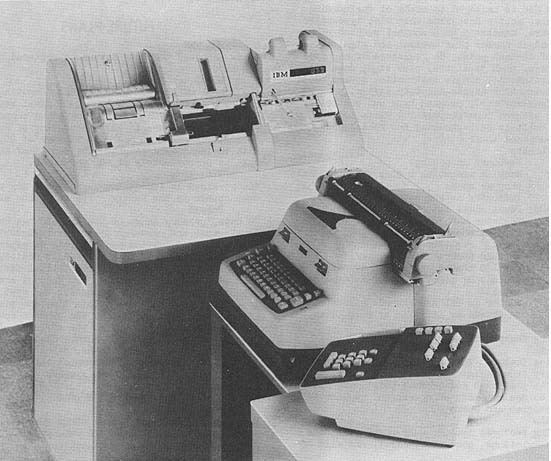 | ||
The IBM 632 was a valve-and-relay driven basic (very basic) accounting machine, introduced in 1958, that was available in seven different models. It consisted of an IBM Electric typewriter and at least a punched card unit (like the IBM 024) that housed the "electronics" in two gates (a relay gate and an electronic gate). Some machines also had a card reader unit (like the IBM 026). A small core memory provided storage for 8 numeric 12 digit words.
The machine was programmed primarily with a plastic tape that moved synchronously with the typewriter carriage. Each tape would typically handle one application. The tape mechanism was mounted behind the carriage in the typewriter unit. Further programming was provided in the card machines program drums. Programs were only executed as the machine typed or spaced over a column - tabbing or carriage returning was not recognised.
As the typewriter carriage moved from field to field three program entries were available in the last three columns of each field - as I recall they were Calc1, Calc2, and Pgm. One calculation was allowed in each Calc column. The PGM field allowed a program instruction - a jump in the form of a "jump" to a new column then auto printout of a calculated field (including decimal place control) as well as punched card control, etc. The PGM column was actually the column the typewriter would space to after typing the last character in the field (either under operator or PGM control).
For example, after entering "price" then tabbing and entering "qty", the machine could automatically space through a dummy field, calculate the $amount on the way and then continue to print it out. The PGM field could then have dictated a carriage return, ready for the next entry.
Two programs were allowed on each tape: primary and alternate. But by resetting the tab-stops it was possible to overlap programs in amazingly complex ways.
Adding was carried out electronically, but multiplication was electro-mechanical. The machine gave off a characteristic kerr-ick-kit-i-tic, kerr-ick-kit-i-tic sound as the relays worked furiously. Multiplication took 3 or 4 seconds, addition, on the other, hand was immediate.
Most machines were used for some type of order-entry/invoicing application, providing a hard-copy invoice and a punched card that could be processed further on some other system. Those with a card reader could do some of that processing themselves, especially if augmented with a sorter.
Cost, price and rental rates
Maintenance/service was included in all monthly rental prices. Maintenance/service for purchased machines was additional.
